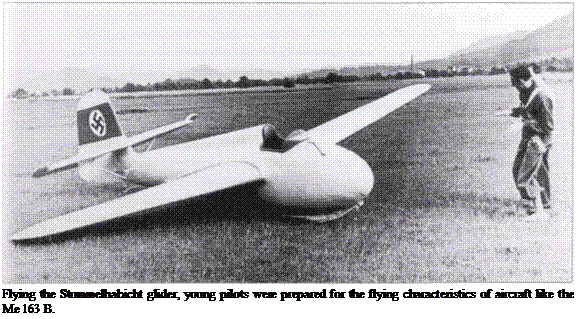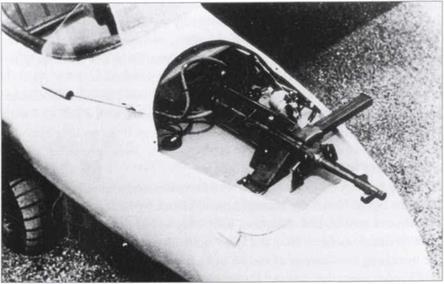New Training Projects
In place of the Me 163, and to fill the void until the appearance of the Но IX (later Go 229), the He 162 Volksjagerwzs considered. A telex dated 15 September 1944 from OKL to Generalmajor Galland, General Adolf Dickfeld of Luftwaffe recruitment, the Reich Youth leader Artur Axmann and Oberst von Below, Hitler’s Luftwaffe adjutant, suggested that Hider Youth pilots should fly this single-jet fighter.
On 25 September Hitler became aware that Himmler was proposing to form the first Waffen-SS fighter unit with the Volksjager. Unlike Goring and the RLM experts, Hider had no objection in principle. The situation came to a head when it became known that the Waffen-SS was attempting to recruit Luftwaffe officers and specialists in development and air armaments for the formation of an SS-Luftwaffe. Inducements were being offered in the form of quick promotions. Reich Youth leader Axmann was interested in the plan. On 1 October 1944 he had a long conversation with Generaloberst Alfred Keller, the influential NSFK leader, and Major Werner Baumbach regarding the use of Hitler Youth to fly the He 162 and so give the Reich air defence a new impetus. Keller felt that the NSFK should be involved in the great Gewaltaufgabe 162 (perhaps best translated as the ‘He 162 Extreme Measures Programme’). He was intending to conscript an entire Hider Youth year of entrants immediately after their glider training. There would be no intermediate training with motorised aircraft and aerial gunnery could be practised on the ground, Keller asserted. The fact that these young ‘pilots’would have no tactical knowledge or formation flying experience seemed neither here nor there.
It was in this way that growing fanaticism replaced reality, while vulgar solutions were pursued and postulated as problem-solving based on logic. The NSFK had not only argued for basic aviator training but also for the preparation of fighter pilots for the Me 163. Now came new objectives. The NSFK would not only support the building of the He 162 trainer but also the training of young pilots to man it. This did not seem right to the RLM. High-ranking decisionmakers doubted that the youthful qualities of these young aviators stretched as far as handling the He 162, and particularly not in the heat of combat. Saur only accepted this position later and then decided against having Hitler Youth as
fighter pilots at all. But both the NSFK leader and the SS were sufficiently fanatical to argue for underage pilots and finally use them.
In order to prevent worse, the Luftwaffe undertook the training of the applicants. All volunteers were concentrated in Oesau Company for training but they were not told what kind of machines were to be trained for. Aviation training for young pilots would economise on fuel by using gliders which looked like, and to some extent flew like, the He 162. Winches with a pull of 700 hp were made for getting the first ten two-seater gliders up. If the training machines proved their worth, another 200 were to have been produced with a corresponding number of extra winches.

To produce the training aircraft in the shortest possible time, on 25 October 1944 the NSFK asked the management of Heinkel-Siid for three of its most experienced aeronautical designers. Kurt May would order the materials for 10-40 training machines from the SS to ensure there were no delays. Thanks to the increasing involvement of the SS in Luftwaffe affairs, its influence on the NSFK also grew, the purpose in the medium term being to incorporate it eventually into the SS. Goring, apprised of the details, insisted that training in motorised aircraft was essential in the Luftwaffe. Only in that way could later operations be mounted with some prospect of success. The Luftwaffe high command attempted to make up the deficit in the extremely short training period by the use of special equipment. During the OKL conference on 16 November 1944 the main item on the agenda was the conversion training of pilots for the
|
The Stummelhabicht was armed with an MP 40 machine-pistol for gunnery training against ground targets. |
He 162. This would start with a practice unit using a full-scale cabin simulator with mock-up basic instruments. Next there would be a simulator with working instruments, and then a true He 162 cabin with electrically-driven BMW 003 turbine and a sound unit to provide realistic take-off and in-flight noise. These devices were to be available both to Luftwaffe pilots and Hitler Youth scheduled for the Volksjager. Slow progress had been made by the beginning of 1945, however, and only parts were ever completed and delivered.
In December 1944, OKL produced new plans to use the V-l Reichenberg, a piloted version of the V-l flying bomb, and the Chief-TLR was soon pressing for the early development of the Re 5 version. This had a shorter forward fuselage than the Re 4. There was an option for 250 Re 5s dependent on the flight test results of the first ten prototypes, and then the Re 5, together with the Re 2 for flight instructor training, would be produced as a training machine for the He 162! This new idea came about because no suitable Volksjager-type practice machine was available to provide future pilots with flying experience in a jet. The fifth Reichenberg variant was never completed, however. At the latest by April 1945 OKL had realised that although light and cheap to turn out, it did not match up adequately to the operational demands or the tactical possibilities.











